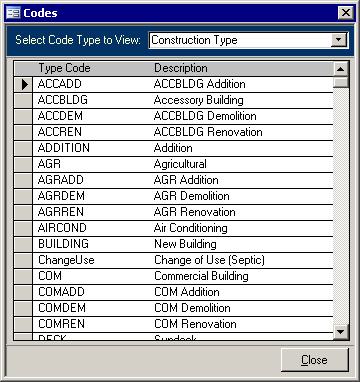The Codes form allows you access to the various codes used in the system. Some lists can be edited, while others cannot be edited and will only accept new
values. Only a few code types allow their codes to be deleted. Of the many codes that can be
viewed, only some are described here. Because they are view only, these records are permanent, but in many cases, you will be able to add new records. Once you save a new permanent code, you can
neither edit nor delete it. Check your spelling before leaving the record. If you change your mind about adding a new code, hit the Esc key twice to remove the record before you leave the
record. Once it has been saved, you will only be able to change the description, amount and sorting fields when they are present. Of the many codes that can be
viewed, only some are described here. Because they are view only, these records are permanent, but in many cases, you will be able to add new records. Once you save a new permanent code, you can
neither edit nor delete it. Check your spelling before leaving the record. If you change your mind about adding a new code, hit the Esc key twice to remove the record before you leave the
record. Once it has been saved, you will only be able to change the description, amount and sorting fields when they are present.
- Authorities:
Used on the Authorities tab of the Property Inquiry screen, these are permanent codes.
- Inspection Types:
The number of inspection types is quite large. You can add more when they arise. You can also specify which apply to a septic permit.
- Inspection Statuses:
Generally the main statuses allowed for any inspection record are: A - Acceptable, AOD - Acceptable with outstanding deficiencies, or NA
- Not Acceptable. Others can be added to the list if there is a need.
- Committee of Adjustment Statuses:
These statuses are permanent and are used on the COA tab of the Property Inquiry
- Committee of Adjustment Types:
These are also permanent and are also used on the COA tab of the Property Inquiry. Generally there are two types: Minor
Variance and Consent Approval Authority (Severance of Land). When a property owner applies for Minor Variance, the committee of adjustment may " authorize
such minor variance from the provisions of the by-law ... as in its opinion is desirable for the appropriate development or use of the land, building or structure,
if in the opinion of the committee the general intent and purpose of the by-law and of the official plan, if any, are maintained.
" On the other hand, the Consent type allows council to give a consent if satisfied that a plan of subdivision of the land is not necessary for the proper and orderly development of the municipality.
Development Statuses: This list is similar to the COA statuses above.
Development Types: Development Applications get assigned a type like a subdivision plan or a Condominium plan. More development types can be added to the list when needed.
Public Works Jobs: These link the various jobs done in the Public Works Inquiry section to the Payroll Earnings.
Lot Grading Deposit Fees: While the code is permanent, you can change the description and the default amount as well as add new records.
Water Retention (WR)
Water Retention systems need to be inspected. This list allows you to pick what kind of inspection it was be it
annual, monthly, after a major storm, or Spring and Fall (Semi-annually).
WR Inspection States: During the inspection, you can specify that a certain aspect of the water retention system was Satisfactory,
Unsatisfactory, or Not Applicable. If more that these three are needed, they can be added to this code list. This list also includes a sorting field which can make data entry easier.
WR Types: Water retention systems are of a set list of types. Currently that list includes Privy/composting toilet, Cesspool, Greywater,
Trench/filter/other bed, or Holding tank. If new methods of retaining water are created in the future, use the Codes form to add them in.
Sewer System: The sewer system section uses several codes, like Classes, Conditional Permit Codes, General Conditions, Tank Types, Vegetation Levels, and
Water Linescan, to which new records can be added.
Zoning Codes: The MPAC manual states that the "zoning of a property is indicated by a seven-digit (maximum) alpha and/or numeric
code as defined by the local municipal planning authority. It exists only for primary records."
Construction Types, Property Usages, and Areas also have a delete button that allows you to remove codes from the list if they are not in use. The Areas list also gives
access to the Change Areas form, so the data can be cleaned up. |